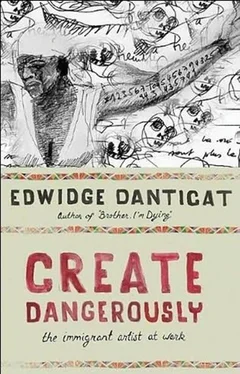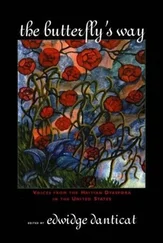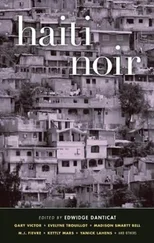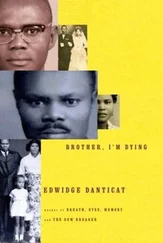“i have not written one word,” the Palestinian American poet Suheir Hammad, paradoxically, wrote soon after September 11th, “no poetry in the ashes south of canal street.”
One of the people in the ashes south of Canal Street was Michael Richards, a U.S.-born sculptor of Jamaican ancestry who had created a bronze cast statue of himself dressed as an African American World War II combat pilot, a Tuskegee airman, with dozens of miniature airplanes shooting through his body. Richards had a studio on the ninety-second floor of Tower One of the World Trade Center and was there when the first plane struck the building at 8:45 a.m. He had spent the night working on, among other things, a piece showing a man clinging to a meteor as it plunges from the sky. Richards had been interested in aviation and flight and had used them as motifs in his work for many years.
I did not know Michael Richards, but being both terrified and intrigued by the folklore of flight, I admired his work, which sometimes seemed like visual depictions of characters in pieces of literature that I loved. His pierced Tuskegee airman reminded me of Toni Morrison’s flying insurance salesman in Song of Solomon , who wrote what must be one of the most eloquent farewell notes in the world, ending with “On Wednesday the 18th of February, 1931, I will take off from Mercy and fly away on my own wings. Please forgive me, I loved you all.”
Michael Richards’s Are You Down , a series of life-size sculptures of three fallen Tuskegee airmen, remind me of Ralph Ellison’s short story “Flying Home,” in which a young pilot crashes his plane and hurts himself, forcing him to ponder a lifelong love affair with airplanes. Winged shows two joined arms with feathers attached to them. Those arms too were Michael Richards’s, cast in bronze and eerily reminiscent of the men and women jumping from the towers on September 11th, with their arms flapping as though they were trying to fly.
Did Michael Richards know how he was going to die? Did he somehow sense that his own body would one day represent that of so many? Maybe he was clairvoyant, what some might call “double-sighted.” One can’t help but hope that like the old Africans, suddenly remembering that he had the gift of flight and seeing the airplanes heading for him, he stepped out of his earthly body and flew away. In any case, he surely must have known what we all instinctively know, that we must all die and that whenever it is we die, it is always a day, a week, a month, a year, a lifetime too soon.
“The poet turns the world to glass, and shows us all things in their right series and procession,” Ralph Waldo Emerson wrote. “For through that better perception he stands one step nearer to things, and sees the flowing or metamorphosis… that within every creature is a force impelling it to ascend into a higher form.”
Michael Richards was a poet of bronze and stone. He was the sculptor of private spaces and public gardens, except his gardens were purposely filled with tar and ashes. His death was no more tragic than that of the nearly three thousand other people who also left behind fingerprints on half-filled glasses and lipstick traces on collars and strands of hair on brushes and combs, but he leaves behind something that speaks not only for himself but also for them.
“He rose one day according to his habit, before the dawn, and saw the morning break, grand as the eternity out of which it came,” Emerson wrote of a sculptor from his youth, “and for many days after, he strove to express this tranquility, and lo! his chisel had fashioned out of marble the plan of a beautiful youth.”
Emerson’s sculptor had extracted youth from marble. Michael Richards had repeatedly chiseled himself as a dying man in agony, in pain. He had linked the European warrior Sebastian to the cunning southern African American trickster Tar Baby, titling his representation of his airplane-pierced body Tar Baby vs. Saint Sebastian . He had sculpted not one but two of his Tar Baby vs. Saint Sebastian statues, one that perished with him in the towers, and a second that was stored and then rediscovered in a cousin’s garage.
Michael Richards was born in New York City, but grew up in Kingston, Jamaica, and then returned to New York as a young man, making him an American who was often called an immigrant. In Richards’s obituary in The Independent , the art critic Adrian Dannat wrote, “Richards had gone against the expectations of his Jamaican family in becoming an artist, an extremely rare profession in a society dominated by bourgeois conventions of financial success.” His friend, the art curator Moukhtar Kocache, told the Village Voice that Richards’s work featured “men who were alienated and unacknowledged, using that for his own existential feelings as a black man, an artist, an immigrant.”
“The highest minds of the world have never ceased to explore the double meaning, or shall I say quadruple or the centuple or much more manifold meaning, of every sensual fact,” Emerson wrote in his essay “The Poet.” “For we are not pawns and barrows, nor even porters of the fire and torch bearers, but children of the fire, made of it.”
Michael Richards was a child of the fire. He often remade himself in it, using his body, over and over again, as his template.
In Ralph Ellison’s “Flying Home,” an old man asks Todd, the fallen young pilot, “Son, how come you want to fly way up there in the air?”
“Because,” Todd replies, “… It’s as good a way to fight and die as I know.”
This leads Todd to think about a time in his childhood when he would chase the shadows of passing airplanes, thinking he could somehow capture and own them. Even the fact that the planes were being used to dump hateful and racist flyers did not diminish his admiration.
“Above he saw the plane spiraling gracefully, agleam in the sun like a fiery sword. And seeing it soar he was caught, transfixed between a terrible horror and a horrible fascination,” wrote Ellison.
Unable to accept the swift reality of sudden death, I’d like to think that Michael Richards had a final moment when he was downright enthralled and mesmerized by his-our-horrible fascination. Or that maybe he had enough time to stop and whisper, “I will take off… and fly away on my own wings. Please forgive me, I loved you all.”
Welcoming Ghosts
It was a testy interview and part of it still lives on in cyberspace via a clip on YouTube. The art historian Marc Miller asks the twenty-one-year-old graffiti artist, painter, musician, and one-time film star Jean-Michel Basquiat about his roots.
“You’re what?” demands Miller. “Haitian-Puerto Rican?”
“I was born here,” answers Basquiat, “but my mother’s fourth-generation Puerto Rican. My father comes from Haiti.”
“Do you feel that that’s in your art?” continues Miller.
“Genetically?” Basquiat interrupts.
“Yeah,” replies Miller. “Genetically or culturally?”
“Culturally?” Basquiat wonders out loud, almost as if speaking to himself. “I guess so.”
“Haiti’s of course famous for its art,” Miller adds.
“That’s why I said genetically,” Basquiat replies while fidgeting and looking away, “because I’ve never been there. And I grew up in, you know, principal American vacuum. Television mostly.”
“No Haitian primitives on your wall?” asks Miller.
“At home?” asks Basquiat, picking up a trace of Miller’s sarcasm and running with it. “Haitian primitives? What do you mean? People? People nailed up on my walls?”
“I mean paintings,” Miller answers, chuckling. “Paintings.”
Читать дальше












